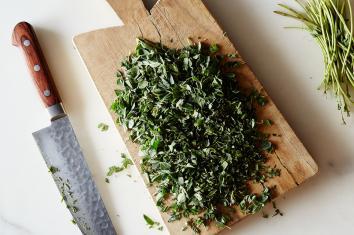This post originally appeared on Food52.
Fast forward to tonight. You’re standing at the fridge again, eyeing disparate ingredients, unsure how you will turn them into a dinner that feels whole.
Here’s a handy new mental pathway for those moments, thanks to Sam and Sam Clark’s Moro: The Cookbook—bread sauce.
Bread sauce could be romesco or tarator or a British version literally named bread sauce. (“Don’t think you can cheat and use a shop-bought one,” says Jamie Oliver.) The only requirement for bread sauce is leftover heels of the stuff, which, even after the apocalypse, will still be falling out of my freezer—yours too, I imagine.
Not only is bread sauce a means of making more out of those castaways, it’s also a vegan alternative to other saucing and binding agents like eggs and cream and butter—and, perhaps more importantly, a cleaner carrier of flavors.

Photo by James Ransom
In the Moro template, after first crisping up cubes of bread in olive oil, you’ll sprinkle in layers of garlic, cumin seeds, crushed chile, saffron, and an entire bunch of fresh oregano to form the base for your sauce. (Sometimes making a sauce means tempering eggs or making a roux; here, it’s pouring red wine vinegar over your bready mix and mushing it up in a mortar and pestle till it sticks together.)
This is your dinner-maker. Sam and Sam Clark use it to marry chickpeas and spinach, but it could just as easily be lentils and mushrooms, roast chicken and leeks, broccoli rabe and penne. You could have instead toasted up the bread with whatever flavors you’re interested in tonight: fennel seeds or fresh thyme or coriander or mustard. Deb Perelman’s version on Smitten Kitchen had tomato sauce, and now she won’t make bread sauce without it. It’s a slot machine dinner with smushed breadcrumbs as the wildcard.

Photo by James Ransom
Moro’s version, however, is also perfect as-is. If you want guidance, follow them. It will be feisty, but it won’t be too much. In fact, the Moro cookbooks might be known as go-to sources for Spanish- and Moorish-influenced recipes, but I think of them as places to find vibrant, smoky, full-bellied meals made entirely from plants (see also this genius salad).
Is serving it on fried bread a little too much? Yes.
Moro’s Chickpeas with Spinach (Garbanzos con Espinacas)
Adapted slightly from Moro: The Cookbook
Serves 4
200 grams (7 ounces) chickpeas, rinsed and soaked overnight with a pinch of baking soda; or two 400-gram tins cooked chickpeas, rinsed
6 tablespoons olive oil
500 grams (18 ounces) spinach, washed
75 grams (3 ounces) white bread (about two ½-inch slices), crusts removed, cut into small cubes
3 cloves garlic, thinly sliced
¾ teaspoon cumin seeds
1 small bunch fresh oregano, roughly chopped
1 small dried red chile, crumbled
1½ tablespoons good-quality red wine vinegar
A good pinch saffron (about 60 threads), infused in 4 tablespoons boiling water
½ teaspoon smoked Spanish paprika
Sea salt and black pepper
See the full recipe at Food52.
Got a genius recipe to share—from a classic cookbook, an online source, or anywhere, really? Please send it my way (and tell me what’s so smart about it) at kristen@food52.com. Thanks to our Design & Home Editor Amanda Sims and Deb Perelman at Smitten Kitchen for this one!
More From Food52:
7 Ways to Cook With Frozen Spinach
If You Like Avocado Toast, You’ll Love This
My Favorite Mostly Cheap, Very Easy, and Extremely Good-Tasting Recipe
10 Things You Should (or Shouldn’t) Eat With Peanut Butter
How to Feel Chic While Eating Lentil Soup
Bodega Eggs: The Stupid-Easy Way to Make Eggs
